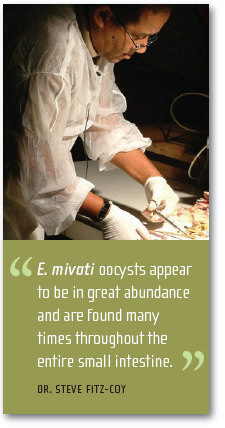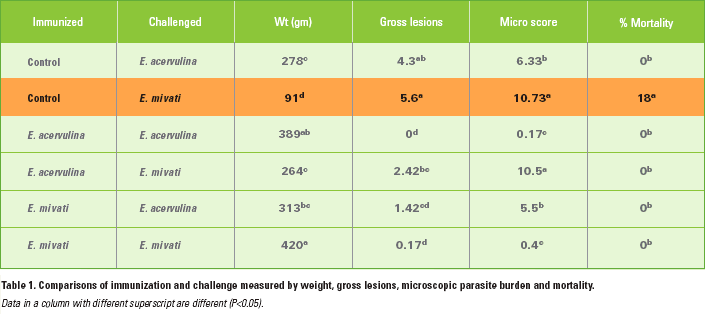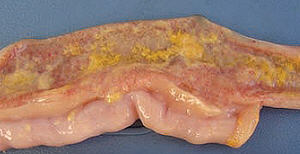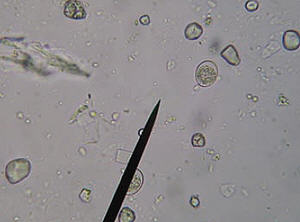
Leaving Its Mark

Poultry producers should take a second look at their control
strategies for coccidiosis following reports that the parasite
Eimeria mivati is indeed a distinct species found in about
35 percent of broiler flocks, says Steve Fitz-Coy, PhD, of
Schering-Plough Animal Health technical services.
This coccidian species has been controversial
among poultry pathologists. Some
believe it to be a variant of E. acervulina
or a mixture of E. acervulina and E. mitis,
but careful study of E. mivati by Fitz-Coy,
a parasitologist, indicates otherwise.
In a study with broilers, Fitz-Coy
immunized one group of birds with
E. acervulina and a second group with
a strain he identified as E. mivati. A
third group served as controls, was
coccidian-free and received anticoccidials
for two weeks.
The birds were then inoculated with
either E. acervulina or E. mivati 3 times weekly for 3 weeks. At 28 days of age,
they were randomly challenged by gavage
with 500,000 sporulated oocysts of either
E. acervulina or E. mivati. Unimmunized
control birds were also challenged with
one or the other Eimeria species.
Six days after challenge, the birds were
evaluated for weight, gross lesions (Figure
1) and microscopic evidence of parasite
burdens, says Fitz-Coy, who presented
these findings last year at the Poultry
Science Association annual meeting.
Pathogenicity
Birds challenged with the same species
they were immunized with had protection,
but birds challenged with the other species—a heterologous species—had
no protection, Fitz-Coy says.
"E. mivati was more pathogenic than
E. acervulina because it caused greater
growth suppression, more gross lesions
(see Figure 1) and more microscopic
parasitism than E. acervulina. In addition,
the only mortality—18%—occurred in
the controls that were challenged with
E. mivati (Table 1), says Fitz-Coy. He
notes that it has been reported that
E. acervulina seldom causes death and
that he has never conducted a challenge
study with E. acervulina that resulted
in deaths.

Birds immunized with E. acervulina and
then challenged with E. mivati did not
experience mortality, but had decreased
weight and a moderately severe level of
parasitism, he says.
In additional studies conducted by
Fitz-Coy using coccidia-naïve chickens
inoculated with semi-purified inocula,
E. mivati produced mortality that ranged
from 20% to 50%.
Fitz-Coy has also sent samples of
E. mivati for independent polymerase chain reaction (PCR) testing, which was
set up to find well-known pathogenic
species of Eimeria such as E. acervulina,
but not E. mivati. The test yielded
negative results-it couldn't identify
the specimens he sent, further indicating
that E. mivati is a distinct species, the
researcher notes.
Incidence

Figure 1. Gut lesions caused by
E. mivati.
When E. mivati was first identified by
Dr. S. Allen Edgar in 1959 during a
persistent coccidiosis outbreak on poultry
farms in Florida, Edgar reported that the
incidence was as high as 50%.
Since 2003 to present, Fitz-Coy has
conducted necropsy sessions and tested
litter samples from chicken houses in
numerous states, looking for E. mivati
oocysts as Edgar first described them:
smaller than E. acervulina and broadly
oval (Figure 2). Based on this work, he estimates the incidence of E. mivati to be
around 35%; that's a lower incidence
compared to E. acervulina, but E. mivati
appears to be more pathogenic and can
still cause losses for producers, Fitz-Coy
says (Figure 3).

Figure 2. An E. Mivati oocyst is at the end of the arrow, slightly to the right. E. Mivati oocysts are broadly oval and slightly smaller than E. Acervuliner oocysts |
|

Figure 3. Studies to date indicate that E. mivati in the United States is lower in incidence than E. acervulina, but more pathogenic.. |
So far, Fitz-Coy has found
E. mivati
in poultry house samples from Georgia,
South Carolina, North Carolina,
Virginia, Delaware, Maryland, Missouri,
Louisiana, Pennsylvania, California,
Texas and Arkansas. There are several poultry-producing states that he's not
yet obtained samples from, such as
Kentucky and Ohio.
"
E. mivati oocysts appear to be in great
abundance and are found many times
throughout the entire small intestine.
E. mivati is present in poultry houses,
it is not
E. acervulina, it is pathogenic,
prevalent - and it can kill chickens,"
Fitz-Coy says.
Spring 2008
Back to North American Edition (#1)














